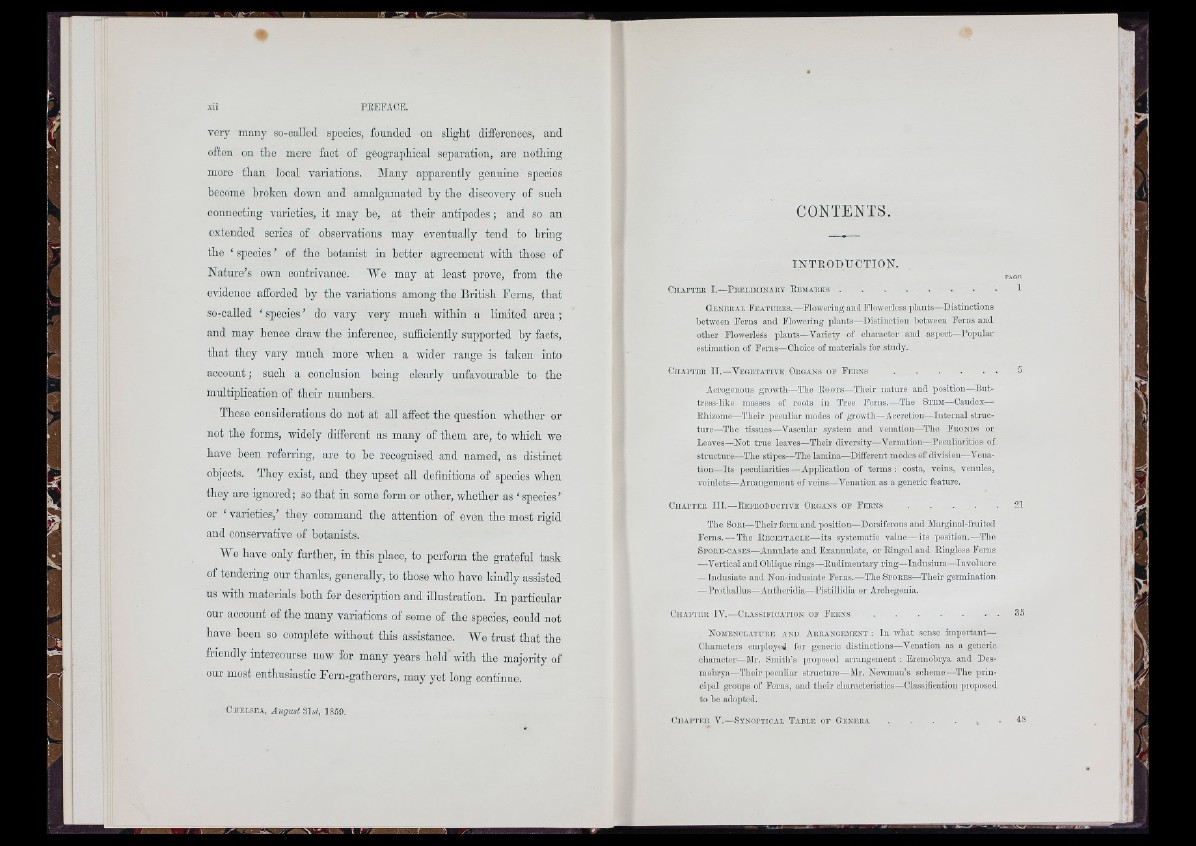
very many so-oallod species, founded on slight differences, and
often on tho more fact of geographical separation, are nothing
moro than local variations. Many apparently genuine species
become broken down and amalgamated by tho discovery of such
connecting varieties, it may bo, at thoir antipodes ; and so an
extended scries of observations may eventually tend to bring
tbo ‘ species ’ of the botanist in bettor agreement with those of
Nature’s own contrivance. We may at least prove, from tho
evidence afforded by the variations among the British Ferns, that
so-called ‘ species ’ do vary very much within a limited a r e a ;
and may hence draw tho inference, sufficiently supported by facts,
th a t they vary much more when a wider range is taken into
account; such a conclusion hoiiig clearly unfavourable to the
multiplication of their numbers.
These considerations do not at all affect the question whether or
not the forms, widely different as many of them are, to which we
have been referring, are to be recognised and named, as distinct
objects. They exist, and they upset all definitions of species when
they are ignored; so that in some form or other, whether as ‘ species’
or ‘ varieties,’ they command the attention of oven the most rigid
and conservative of botanists.
We have only further, in this place, to perform the grateful task
of tendering our thanks, generally, to those who have kindly assisted
us with materials both for description and illustration. In particular
our account of the many variations of some of the species, could not
have been so complete without this assistance. We trust that the
friendly intercourse now for many years held with the majority of
our most enthusiastic Fern-gatliorers, may yet long continue.
C11EL.SEA, Aiigiist 31si, 1869.
CONTENTS.
I N T R O D U C T I O N .
C h a p t e r L — P r e l im in a r y R e m a r k s ...........................................................................
G e n e r a l F e a t u r e s .—Flowering and Flowerlcss p lan ts—Distinctions
between Ferns and Flowering plants—Distinction between Ferns and
otlior Flowerless p lan ts—Variety of character and aspect—Popular
estimation of Foms—Choice of materials for study.
PAO It
1
C iiA F rE R I I .—V e g e t a t i v e O r g a n s o f F e r n s
Acrogenoiis growth—The R o o t s—Their n ature and position—Bnt-
tress-like masses of roots in Tree Ferns.—The S t e m —Caudcx—
Rhizome—Their peculiar modes of gi’owth—Accretion—In te rn a l structu
re—The tissues—Vascular system and venation—The F r o n d s or
Leaves—N o t tru e leaves—Their diversity—Vernation—Peculiarities of
stru ctu re—The stipes—The lamina—Diii'crcnt modes of division—Venation—
Its peculiarities— Application of terms : costa, veins, venules,
veinlets—Arrangement of veins—Venation as a generic feature.
C h a p t e r I I I .—R e p r o d u c t i v e O r g a n s o f F e r n s
The S o r i— Tlieir form and position—Dorsiferous and Marginal-fruited
Ferns. — Tlie R e c e p t a c l e— its systematic value —its position.—Tho
S p o r e - c a s e s— Annulate and Exaniiulate, or Ringed and Ringlcss Ferns
—Vertical and Oblique rings—Rudimentaiy ring—Indusium—Involucre
— Indusiate and Noii-indusiate Fern s.—Tlie S p o r e s—Their gennination
—Pro th allu s—Aiitheridia—Pistillidia or Archegonia.
CiiAPTKR IV .—C l a s s i f i c a t i o n o f F e r n s
N o m e n c l a t l t r e a n d A r r a n g e m e n t : In what sense important—
Characters employed for generic distinctions—Venation as a generic
character—Mr. Smith’s proposed arrangement : Ereniobrya and Des-
mobrya—Their peculiar s tru c tu re—Mr. Newman’s scheme—The p rin cipal
groups of Ferns, and th e ir characteristics—Classification proposed
to be adojited.
C h a p t e r V .— S y n o p t ic a l T a b l e o f G e n e r a . . . . ^ •
21
35
48